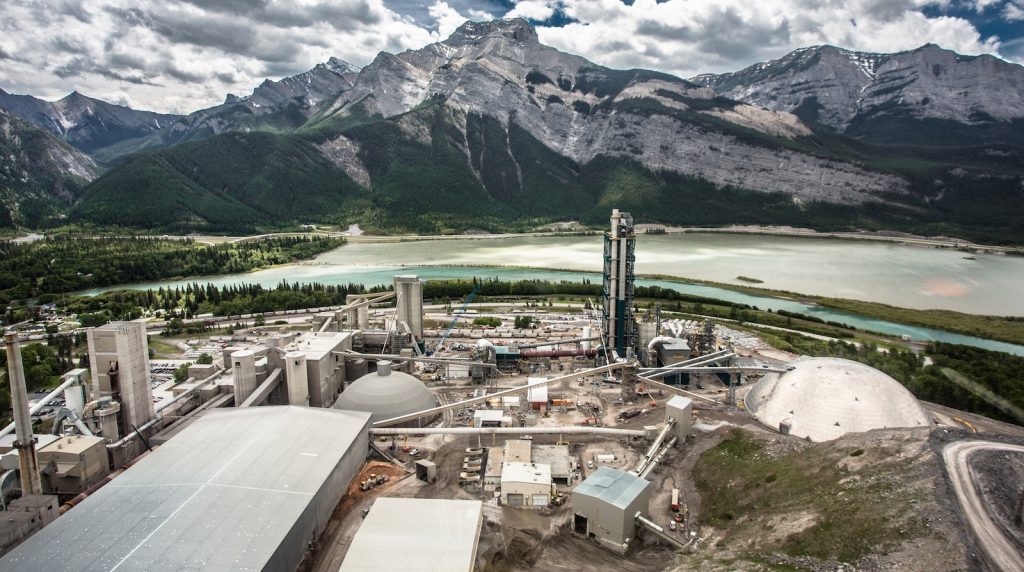
Features
Aggregates
Technology
Lafarge hosts major lower carbon rules research project with academic and NGO partners
January 18, 2018 By Lafarge Canada
 Photo: Lafarge Canada
Photo: Lafarge CanadaJanuary 18, 2018 – Lafarge Canada Inc. and its partners – University of Calgary, Queen’s University, and Pembina Institute – are conducting a million-dollar study on the environmental benefits of introducing lower carbon fuels at its Exshaw Cement Plant. Building from previous research, this multi-partner, multi-site lower carbon fuels project is the most significant of its kind in Canada.
“Our estimates show each 20 per cent incremental replacement of natural gas at the Exshaw Cement Plant with lower carbon fuels could result in the elimination of nearly 75,000 tonnes per year of CO2. This is the equivalent of taking over 16,000 cars off the road annually. While these are preliminary estimates, this research project will assess these figures precisely and in the local context,” said Rob Cumming, environmental director for Lafarge.
Eight lower carbon fuels will be researched, including construction renovation/demolition waste, non-recyclable plastic, carpets and textiles, shingles, treated wood products, wood products, rubber and tire derived fuels. These sources of fuel have been successfully used at other Lafarge cement plants in Canada and around the world.
“This project is an important step forward in understanding the opportunities for reducing GHG emissions at cement plants in Alberta and across Canada. The partnership between industry, two provinces, and the federal government represents an example of the collaborative efforts required to advance low-carbon innovation,” stated Steve MacDonald, CEO of Emissions Reductions Alberta.
Air quality and traffic impact studies predict minimal changes with introducing lower carbon fuels at the Exshaw Cement Plant. Additional research by the partners will measure the environmental components associated with the sourcing, processing and full-scale commercial operation of each lower carbon fuel compared to fossil fuels. The project will also measure the benefits of diverting materials from landfills and determine optimal points in the cement manufacturing process to inject each fuel.
“Lab simulations, environmental studies, economics and logistics reviews are already underway. All research will be finalized by December 2019 with regular updates provided to the neighbouring communities via a Public Advisory Committee,” comments Jim Bachmann, Exshaw Plant Manager.
In addition to Lafarge’s support, research funding is being provided by Alberta Innovates, Ontario Centres of Excellence (OCE), Emissions Reduction Alberta (ERA), and the Natural Sciences and Engineering Research Council of Canada (NSERC). It includes research by Millennium EMS Solutions Ltd., Geocycle, and WSP Global Inc.
In alignment with LafargeHolcim’s 2030 Sustainability Plan, Lafarge aims to replace 30 to 50 per cent of fossil fuel use at its Canadian cement plants with lower carbon fuels by 2020.
“NSERC is proud to support this Collaborative Research and Development award that connects Canada’s brain trust and companies like Lafarge Canada to develop innovative solutions to decrease Canada’s carbon footprint in the cement industry by exploring new fuel pathways. This collaboration will be a major contributor to reducing greenhouse gas emissions, providing significant environmental and economic benefits to Canada,” said Bert van den Berg, acting vice-president for research partnerships at NSERC.
About Lafarge Canada Inc.
Lafarge is Canada’s largest provider of diversified construction materials and a member of the global group, LafargeHolcim. With 6,000 employees and 400 sites across Canada, our mission is to provide construction solutions that build better cities and communities. The cities where Canadians live, work, and raise their families along with the community’s infrastructure benefit from the solutions provided by Lafarge consisting of aggregates, asphalt and paving, cement, precast concrete, ready-mix concrete and road construction.
Through LafargeHolcim’s 2030 Plan, Lafarge is committed to providing solutions using sustainable manufacturing practices and improving the environment in and around its operations. The company has a sixty year history in Canada and works continually to reduce carbon dioxide emissions, restore wetlands for native plants and animals, and identify waste materials that can be recycled and used in our operations. For more information: www.lafarge.ca.
Print this page